国际财务管理(东财 2014)附答案
东财《国际财务管理》课程考试复习题 参考答案

东财《国际财务管理》课程考试复习题参考答案一、单项选择题(下列每小题的备选答案中,只有一个符合题意的正确答案,多选、错选、不选均不得分。
本题共30个小题,每小题2分)1. 国际证券组合投资可以降低()。
A .系统风险B .非系统风险C .市场风险D .不可分散风险【答案】B2. 如果票面利率小于市场利率,此时债券应该()发行。
A .溢价B .折价C .平价D .以上答案都可以【答案】B3. 以下风险中最重要的是()。
A .商品交易风险B .外汇借款风险C .会计折算风险D .经济风险【答案】D4. 如果某项借款名义贷款期为10年,而实际贷款期只有5年,则这项借款最有可能采用的偿还方式是()。
A .到期一次偿还B .分期等额偿还C .逐年分次等额还本D .以上三种都可以【答案】C5. 在国际信贷计算利息时以365/365来表示计息天数与基础天数的关系称为()。
A .大陆法B .欧洲货币法C .英国法D .时态法【答案】C6. 欧洲货币市场的主要短期信贷利率是()。
A .LIBORB .SIBORC .HOBORD .NIBOR【答案】A7. 一国政府、金融机构、公司等在某一外国债券市场上发行的,不是以该外国的货币为面值的债券是()。
A .普通债券B .国内债券C .欧洲债券D .外国债券8. 在对国外投资的子公司进行财务评价时,应扣除的子公司不可控因素不包括()。
A .转移价格B .利率波动C .通货膨胀D .汇率波动【答案】B9. 在国际技术转让中,利润分享率一般认为应是()。
A .1/2B .1/3C .1/4D .1/5【答案】C10. 美国A公司预测美元对英镑美元升值,美元对马克美元贬值,则A公司()。
A .从英国的进口,应加快支付B .对英国的出口,应推迟收汇C .从德国的进口,应推迟支付D .对德国的出口,应推迟收汇【答案】D11. "使用外资收益率"这一指标等于1减去()。
国际财务管理——东北财经大学
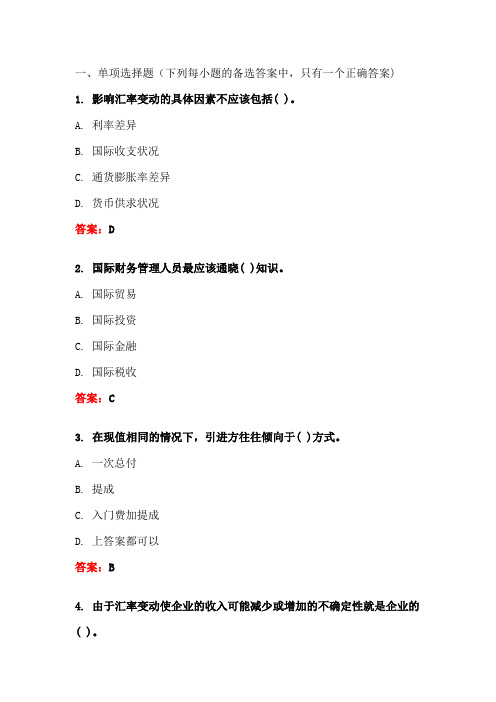
一、单项选择题(下列每小题的备选答案中,只有一个正确答案)1. 影响汇率变动的具体因素不应该包括( )。
A. 利率差异B. 国际收支状况C. 通货膨胀率差异D. 货币供求状况答案:D2. 国际财务管理人员最应该通晓( )知识。
A. 国际贸易B. 国际投资C. 国际金融D. 国际税收答案:C3. 在现值相同的情况下,引进方往往倾向于( )方式。
A. 一次总付B. 提成C. 入门费加提成D. 上答案都可以答案:B4. 由于汇率变动使企业的收入可能减少或增加的不确定性就是企业的( )。
A. 财务风险B. 外汇风险C. 政治风险D. 法令风险答案:B5. “跨国公司有时还会利用外汇预测进行外汇买卖的投机活动”这句话( )。
A. 正确B. 错误C. 其他D. 以上答案都不对答案:A6. 适用于跨国总公司和分公司之间纳税抵免的是( )。
A. 免税B. 税收扣除C. 直接抵免D. 间接抵免答案:C7. 衡量企业短期的偿还能力的指标是( )。
A. 流动比率B. 偿还期C. 已获利息倍数D. 或有负债率答案:A8. 在所有的DR中,( )出现最早,最具有代表性。
A. HKDRB. GDRC. EDRD. ADR答案:D9. 企业选择外汇借款的货币种类时,应选择借款成本率( )的那种货币。
A. 等于零B. 等于无穷大C. 最高D. 最低答案:D10. 在两种方式选择的决策中,应使用的最终指标是现金流出量的( )。
A. 终值B. 现值C. 终值与现值的平均数D. 终值与现值的总和答案:B11. 给予持有者执行或放弃合约选择权的是( )。
A. 即期外汇交易B. 远期外汇交易C. 期权外汇交易D. 期货外汇交易答案:C12. 承租人租入设备后占用出租方的资金,由于分期支付租金而应支付给出租方的利息是( )。
A. 租赁设备的价款B. 租赁业务的海运费、保险费C. 租赁手续费D. 融资利息答案:D13. 以下不是技术卖方应考虑的因素的是( )。
春东财国际财务管理在线作业一二三标准答案 (1)
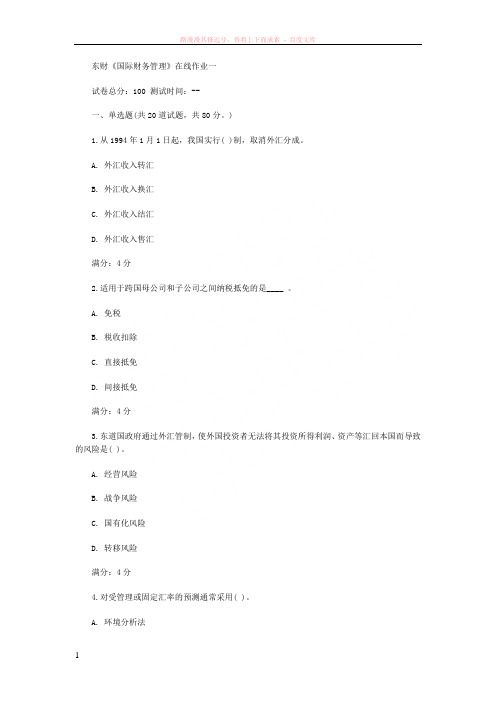
东财《国际财务管理》在线作业一试卷总分:100 测试时间:--一、单选题(共20道试题,共80分。
)1.从1994年1月1日起,我国实行( )制,取消外汇分成。
A. 外汇收入转汇B. 外汇收入换汇C. 外汇收入结汇D. 外汇收入售汇满分:4分2.适用于跨国母公司和子公司之间纳税抵免的是____ 。
A. 免税B. 税收扣除C. 直接抵免D. 间接抵免满分:4分3.东道国政府通过外汇管制,使外国投资者无法将其投资所得利润、资产等汇回本国而导致的风险是( )。
A. 经营风险B. 战争风险C. 国有化风险D. 转移风险满分:4分4.对受管理或固定汇率的预测通常采用( )。
A. 环境分析法B. 评分分析法C. 图表分析法D. 因素分析法满分:4分5.“年现金股利除以股票的购入价格”衡量的是( )。
A. 持有期间收益率B. 本期股利收益率C. 资产增值收益率D. 以上答案都可以满分:4分6.产品返销指的是____ 。
A. 直接产品补偿B. 间接产品补偿C. 加工费补偿D. 租赁补偿满分:4分7.企业支付给职工的外汇工资、奖金和津贴属于( )。
A. 贸易付汇B. 贸易从属费用付汇C. 技术引进付汇D. 非贸易付汇满分:4分8.一人向另一人签发的,要求即期或定期或在可以确定的将来的时间,对某人或其指定人或持票人来支付一定金额的无条件书面支付命令是____ 。
A. 汇票B. 本票C. 支票D. 发票满分:4分9.节约1美元外汇所需要的人民币数额是( )。
A. 外汇净现值B. 换汇成本C. 节汇成本D. 创汇成本满分:4分10.经营租赁也可以称为( )。
A. 金融租赁B. 财务租赁C. 融资租赁D. 使用租赁满分:4分11.短期投资与长期投资是按证券投资的( )而分类的。
A. 对象不同B. 收益是否固定C. 时期不同D. 目的不同满分:4分12.固定收益投资与不固定收益投资是按证券投资的( )而分类的。
A. 对象不同B. 收益是否固定C. 时期不同D. 目的不同满分:4分13.ADR具体可以有( )形式。
国际财务管理课后习题答案chapter
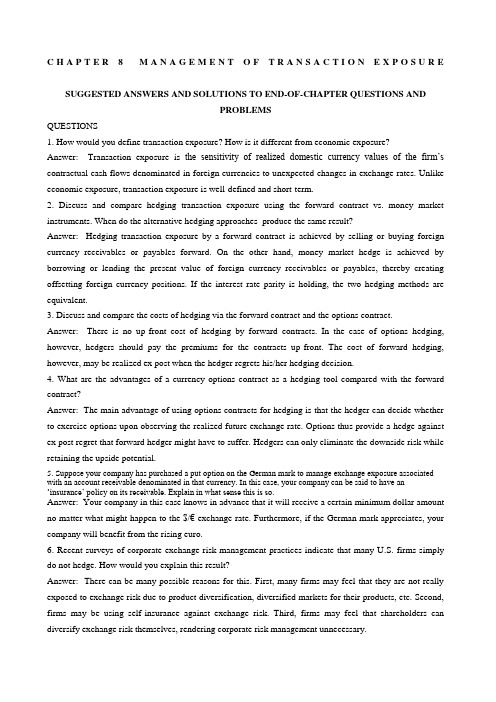
C H A P T E R8M A N A G E M E N T O F T R A N S A C T I O N E X P O S U R ESUGGESTED ANSWERS AND SOLUTIONS TO END-OF-CHAPTER QUESTIONS ANDPROBLEMSQUESTIONS1. How would you define transaction exposure? How is it different from economic exposure?Answer: Transaction exposure is the sensitivity of realized domestic currency values of the firm’s contractual cash flows denominated in foreign currencies to unexpected changes in exchange rates. Unlike economic exposure, transaction exposure is well-defined and short-term.2. Discuss and compare hedging transaction exposure using the forward contract vs. money market instruments. When do the alternative hedging approaches produce the same result?Answer: Hedging transaction exposure by a forward contract is achieved by selling or buying foreign currency receivables or payables forward. On the other hand, money market hedge is achieved by borrowing or lending the present value of foreign currency receivables or payables, thereby creating offsetting foreign currency positions. If the interest rate parity is holding, the two hedging methods are equivalent.3. Discuss and compare the costs of hedging via the forward contract and the options contract.Answer: There is no up-front cost of hedging by forward contracts. In the case of options hedging, however, hedgers should pay the premiums for the contracts up-front. The cost of forward hedging, however, may be realized ex post when the hedger regrets his/her hedging decision.4. What are the advantages of a currency options contract as a hedging tool compared with the forward contract?Answer: The main advantage of using options contracts for hedging is that the hedger can decide whether to exercise options upon observing the realized future exchange rate. Options thus provide a hedge against ex post regret that forward hedger might have to suffer. Hedgers can only eliminate the downside risk while retaining the upside potential.5. Suppose your company has purchased a put option on the German mark to manage exchange exposure associated with an account receivable denominated in that currency. In this case, your company can be said to have an‘insurance’ policy on its receivable. Explain in what sense this is so.Answer: Your company in this case knows in advance that it will receive a certain minimum dollar amount no matter what might happen to the $/€ exchange rate. Furthermore, if the German mark appreciates, your company will benefit from the rising euro.6. Recent surveys of corporate exchange risk management practices indicate that many U.S. firms simply do not hedge. How would you explain this result?Answer: There can be many possible reasons for this. First, many firms may feel that they are not really exposed to exchange risk due to product diversification, diversified markets for their products, etc. Second, firms may be using self-insurance against exchange risk. Third, firms may feel that shareholders can diversify exchange risk themselves, rendering corporate risk management unnecessary.7. Should a firm hedge? Why or why not?Answer: In a perfect capital market, firms may not need to hedge exchange risk. But firms can add to their value by hedging if markets are imperfect. First, if management knows about the firm’s exposure better than shareholders, the firm, not its shareholders, should hedge. Second, firms may be able to hedge at a lower cost. Third, if default costs are significant, corporate hedging can be justifiable because it reduces the probability of default. Fourth, if the firm faces progressive taxes, it can reduce tax obligations by hedging which stabilizes corporate earnings.8. U sing an example, discuss the possible effect of hedging on a firm’s tax obligations.Answer: One can use an example similar to the one presented in the chapter.9. Explain contingent exposure and discuss the advantages of using currency options to manage this type of currency exposure.Answer: Companies may encounter a situation where they may or may not face currency exposure. In this situation, companies need options, not obligations, to buy or sell a given amount of foreign exchange they may or may not receive or have to pay. If companies either hedge using forward contracts or do not hedge at all, they may face definite currency exposure.10. Explain cross-hedging and discuss the factors determining its effectiveness.Answer: Cross-hedging involves hedging a position in one asset by taking a position in another asset. The effectiveness of cross-hedging would depend on the strength and stability of the relationship between the two assets.PROBLEMS1. Cray Research sold a super computer to the Max Planc k Institute in Germany on credit and invoiced €10 million payable in six months. Currently, the six-month forward exchange rate is $1.10/€ and the foreign exchange advisor for Cray Research predicts that the spot rate is likely to be $1.05/€ in six months.(a) What is the expected gain/loss from the forward hedging?(b) If you were the financial manager of Cray Research, would you recommend hedging this euro receivable? Why or why not?(c) Suppose the foreign exchange advisor predicts that the future spot rate will be the same as the forward exchange rate quoted today. Would you recommend hedging in this case? Why or why not?Solution: (a) Expected gain($) = 10,000,000(1.10 – 1.05)= 10,000,000(.05)= $500,000.(b) I would recommend hedging because Cray Research can increase the expected dollar receipt by $500,000 and also eliminate the exchange risk.(c) Since I eliminate risk without sacrificing dollar receipt, I still would recommend hedging.2. IBM purchased computer chips from NEC, a Japanese electronics concern, and was billed ¥250 million payable in three months. Currently, the spot exchange rate is ¥105/$ and the three-month forward rate is ¥100/$. The three-month money market interest rate is 8 percent per annum in the U.S. and 7 percent per annum in Japan. The management of IBM decided to use the money market hedge to deal with this yen account payable.(a) Explain the process of a money market hedge and compute the dollar cost of meeting the yen obligation.(b) Conduct the cash flow analysis of the money market hedge.Solution: (a). Let’s first compute the PV of ¥250 million, i.e.,250m/1.0175 = ¥245,700,245.7So if the above yen amount is invested today at the Japanese interest rate for three months, the maturity value will be exactly equal to ¥25 million which is the amount of payable.To buy the above yen amount today, it will cost:$2,340,002.34 = ¥250,000,000/105.The dollar cost of meeting this yen obligation is $2,340,002.34 as of today.(b)___________________________________________________________________Transaction CF0 CF1____________________________________________________________________1. Buy yens spot -$2,340,002.34with dollars ¥245,700,245.702. Invest in Japan - ¥245,700,245.70 ¥250,000,0003. Pay yens - ¥250,000,000Net cash flow - $2,340,002.34____________________________________________________________________3. You plan to visit Geneva, Switzerland in three months to attend an international business conference. You expect to incur the total cost of SF 5,000 for lodging, meals and transportation during your stay. As oftoday, the spot exchange rate is $0.60/SF and the three-month forward rate is $0.63/SF. You can buy the three-month call option on SF with the exercise rate of $0.64/SF for the premium of $0.05 per SF. Assume that your expected future spot exchange rate is the same as the forward rate. The three-month interest rate is6 percent per annum in the United States and 4 percent per annum in Switzerland.(a) Calculate your expected dollar cost of buying SF5,000 if you choose to hedge via call option on SF.(b) Calculate the future dollar cost of meeting this SF obligation if you decide to hedge using a forward contract.(c) At what future spot exchange rate will you be indifferent between the forward and option market hedges?(d) Illustrate the future dollar costs of meeting the SF payable against the future spot exchange rate under both the options and forward market hedges.Solution: (a) Total option premium = (.05)(5000) = $250. In three months, $250 is worth $253.75 = $250(1.015). At the expected future spot rate of $0.63/SF, which is less than the exercise price, you don’t expect to exercise options. Rather, you expect to buy Swiss franc at $0.63/SF. Since you are going to buy SF5,000, you expect to spend $3,150 (=.63x5,000). Thus, the total expected cost of buying SF5,000 will be the sum of $3,150 and $253.75, i.e., $3,403.75.(b) $3,150 = (.63)(5,000).(c) $3,150 = 5,000x + 253.75, where x represents the break-even future spot rate. Solving for x, we obtain x = $0.57925/SF. Note that at the break-even future spot rate, options will not be exercised.(d) If the Swiss franc appreciates beyond $0.64/SF, which is the exercise price of call option, you will exercise the option and buy SF5,000 for $3,200. The total cost of buying SF5,000 will be $3,453.75 = $3,200 + $253.75.This is the maximum you will pay.4. Boeing just signed a contract to sell a Boeing 737 aircraft to Air France. Air France will be billed €20million which is payable in one year. The current spot exchange rate is $1.05/€ and the one -year forwardrate is $1.10/€. The annual interest rate is 6.0% in the U.S. and 5.0% in France. Boeing is concerned with the volatile exchange rate between the dollar and the euro and would like to hedge exchange exposure.(a) It is considering two hedging alternatives: sell the euro proceeds from the sale forward or borrow euros from the Credit Lyonnaise against the euro receivable. Which alternative would you recommend? Why?(b) Other things being equal, at what forward exchange rate would Boeing be indifferent between the twohedging methods?Solution: (a) In the case of forward hedge, the future dollar proceeds will be (20,000,000)(1.10) =$22,000,000. In the case of money market hedge (MMH), the firm has to first borrow the PV of its euro receivable, i.e., 20,000,000/1.05 =€19,047,619. Then the firm should exchange this euro amount into dollars at the current spot rate to receive: (€19,047,619)($1.05/€) = $20,000,000, which can be invested at the dollar interest rate for one year to yield: $20,000,000(1.06) = $21,200,000.Clearly, the firm can receive $800,000 more by using forward hedging.(b) According to IRP, F = S(1+i $)/(1+i F ). T hus the “indifferent” forward rate will be: F = 1.05(1.06)/1.05 = $1.06/€.5. Suppose that Baltimore Machinery sold a drilling machine to a Swiss firm and gave the Swiss client a choice of paying either $10,000 or SF 15,000 in three months.(a) In the above example, Baltimore Machinery effectively gave the Swiss client a free option to buy up to $10,000 dollars using Swiss franc. What is the ‘implied’ exercise exchange rate?(b) If the spot exchange rate turns out to be $0.62/SF, which currency do you think the Swiss client will choose to use for payment? What is the value of this free option for the Swiss client? (c) What is the best way for Baltimore Machinery to deal with the exchange exposure? Solution: (a) The implied exercise (price) rate is: 10,000/15,000 = $0.6667/SF .(b) If the Swiss client chooses to pay $10,000, it will cost SF16,129 (=10,000/.62). Since the Swiss client has an option to pay SF15,000, it will choose to do so. The value of this option is obviously SF1,129 (=SF16,129-SF15,000).(c) Baltimore Machinery faces a contingent exposure in the sense that it may or may not receive SF15,000 in the future. The firm thus can hedge this exposure by buying a put option on SF15,000.6. Princess Cruise Company (PCC) purchased a ship from Mitsubishi Heavy Industry. PCC owes Mitsubishi Heavy Industry 500 million yen in one year. The current spot rate is 124 yen per dollar and the one-year forward rate is 110 yen per dollar. The annual interest rate is 5% in Japan and 8% in the U.S. PCC can also buy a one-year call option on yen at the strike price of $.0081 per yen for a premium of .014 cents$ Cost Options hedgeForward hedge$3,453.75$3,1500.5790.64(strike price) $/SF$253.75per yen.(a) Compute the future dollar costs of meeting this obligation using the money market hedge and the forward hedges.(b) Assuming that the forward exchange rate is the best predictor of the future spot rate, compute the expected future dollar cost of meeting this obligation when the option hedge is used.(c) At what future spot rate do you think PCC may be indifferent between the option and forward hedge? Solution: (a) In the case of forward hedge, the dollar cost will be 500,000,000/110 = $4,545,455. In the case of money market hedge, the future dollar cost will be: 500,000,000(1.08)/(1.05)(124)= $4,147,465.(b) The option premium is: (.014/100)(500,000,000) = $70,000. Its future value will be $70,000(1.08) = $75,600.At the expected future spot rate of $.0091(=1/110), which is higher than the exercise of $.0081, PCC will exercise its call option and buy ¥500,000,000 for $4,050,000 (=500,000,000x.0081).The total expected cost will thus be $4,125,600, which is the sum of $75,600 and $4,050,000.(c) When the option hedge is used, PCC will spend “at most” $4,125,000. On the other hand, when the forward hedging is used, PCC will have to spend $4,545,455 regardless of the future spot rate. This means that the options hedge dominates the forward hedge. At no future spot rate, PCC will be indifferent between forward and options hedges.7. Airbus sold an aircraft, A400, to Delta Airlines, a U.S. company, and billed $30 million payable in six months. Airbus is concerned with the euro proceeds from international sales and would like to control exchange risk. The current spot exchange rate is $1.05/€ and six-month forward exchange rate is $1.10/€ at the moment. Airbus can buy a six-month put option on U.S. dollars with a strike price of €0.95/$ for a premium of €0.02 per U.S. dollar. Currently, six-month interest rate is 2.5% in the euro zone and 3.0% in the U.S.pute the guaranteed euro proceeds from the American sale if Airbus decides to hedge using aforward contract.b.If Airbus decides to hedge using money market instruments, what action does Airbus need to take?What would be the guaranteed euro proceeds from the American sale in this case?c.If Airbus decides to hedge using put options on U.S. dollars, what would be the ‘expected’ europroceeds from the American sale? Assume that Airbus regards the current forward exchange rate as an unbiased predictor of the future spot exchange rate.d.At what future spot exchange rate do you think Airbus will be indifferent between the option andmoney market hedge?Solution:a. Airbus will sell $30 million forward for €27,272,727 = ($30,000,000) / ($1.10/€).b. Airbus will borrow the present value of the dollar receivable, i.e., $29,126,214 = $30,000,000/1.03, and then sell the dollar proceeds spot for euros: €27,739,251. This is the euro amount that Airbus is going to keep.c. Since the expected future spot rate is less than the strike price of the put option, i.e., €0.9091< €0.95, Airbus expects to exercise the option and receive €28,500,000 = ($30,000,000)(€0.95/$). This is gross proceeds. Airbus spent€600,000 (=0.02x30,000,000) upfront for the option and its future cost is equal to €615,000 = €600,000 x 1.025. Thusthe net euro proceeds from the American sale is €27,885,000, which is the difference between the gross proceeds and the option costs.d. At the indifferent future spot rate, the following will hold:€28,432,732 = S T (30,000,000) - €615,000.Solving for S T, we obtain the “indifference” future spot exchange rate, i.e., €0.9683/$, or $1.0327/€. Note that €28,432,732 is the future value of the proceeds under money market hedging:€28,432,732 = (€27,739,251) (1.025).Suggested solution for Mini Case: Chase Options, Inc.[See Chapter 13 for the case text]Chase Options, Inc.Hedging Foreign Currency Exposure Through Currency OptionsHarvey A. PoniachekI. Case SummaryThis case reviews the foreign exchange options market and hedging. It presents various international transactions that require currency options hedging strategies by the corporations involved. Seven transactions under a variety of circumstances are introduced that require hedging by currency options. The transactions involve hedging of dividend remittances, portfolio investment exposure, and strategic economic competitiveness. Market quotations are provided for options (and options hedging ratios), forwards, and interest rates for various maturities.II. Case Objective.The case introduces the student to the principles of currency options market and hedging strategies. The transactions are of various types that often confront companies that are involved in extensive international business or multinational corporations. The case induces students to acquire hands-on experience in addressing specific exposure and hedging concerns, including how to apply various market quotations, which hedging strategy is most suitable, and how to address exposure in foreign currency through cross hedging policies.III. Proposed Assignment Solution1. The company expects DM100 million in repatriated profits, and does not want the DM/$ exchange rate at which they convert those profits to rise above 1.70. They can hedge this exposure using DM put options with a strike price of 1.70. If the spot rate rises above 1.70, they can exercise the option, while if that rate falls they can enjoy additional profits from favorable exchange rate movements.To purchase the options would require an up-front premium of:DM 100,000,000 x 0.0164 = DM 1,640,000.With a strike price of 1.70 DM/$, this would assure the U.S. company of receiving at least:DM 100,000,000 – DM 1,640,000 x (1 + 0.085106 x 272/360)= DM 98,254,544/1.70 DM/$ = $57,796,791by exercising the option if the DM depreciated. Note that the proceeds from the repatriated profits are reduced by the premium paid, which is further adjusted by the interest foregone on this amount. However, if the DM were to appreciate relative to the dollar, the company would allow the option to expire, and enjoy greater dollar proceeds from this increase.Should forward contracts be used to hedge this exposure, the proceeds received would be:DM100,000,000/1.6725 DM/$ = $59,790,732,regardless of the movement of the DM/$ exchange rate. While this amount is almost $2 million more than that realized using option hedges above, there is no flexibility regarding the exercise date; if this date differs from that at which the repatriate profits are available, the company may be exposed to additional further current exposure. Further, there is no opportunity to enjoy any appreciation in the DM.If the company were to buy DM puts as above, and sell an equivalent amount in calls with strike price 1.647, the premium paid would be exactly offset by the premium received. This would assure that the exchange rate realized would fall between 1.647 and 1.700. If the rate rises above 1.700, the company will exercise its put option, and if it fell below 1.647, the other party would use its call; for any rate in between, both options would expire worthless. The proceeds realized would then fall between:DM 100,00,000/1.647 DM/$ = $60,716,454andDM 100,000,000/1.700 DM/$ = $58,823,529.This would allow the company some upside potential, while guaranteeing proceeds at least $1 million greater than the minimum for simply buying a put as above.Buy/Sell OptionsDM/$SpotPut Payoff “Put”Profits Call Payoff“Call”Profits Net Profit1.60 (1,742,846) 0 1,742,846 60,716,454 60,716,454 1.61 (1,742,846) 0 1,742,846 60,716,454 60,716,454 1.62 (1,742,846) 0 1,742,846 60,716,454 60,716,454 1.63 (1,742,846) 0 1,742,846 60,716,454 60,716,454 1.64 (1,742,846) 0 1,742,846 60,716,454 60,716,454 1.65 (1,742,846) 60,606,061 1,742,846 0 60,606,061 1.66 (1,742,846) 60,240,964 1,742,846 0 60,240,964 1.67 (1,742,846) 59,880,240 1,742,846 0 59,880,240 1.68 (1,742,846) 59,523,810 1,742,846 0 59,523,810 1.69 (1,742,846) 59,171,598 1,742,846 0 59,171,598 1.70 (1,742,846) 58,823,529 1,742,846 0 58,823,529 1.71 (1,742,846) 58,823,529 1,742,846 0 58,823,529 1.72 (1,742,846) 58,823,529 1,742,846 0 58,823,529 1.73 (1,742,846) 58,823,529 1,742,846 0 58,823,529 1.74 (1,742,846) 58,823,529 1,742,846 0 58,823,529 1.75 (1,742,846) 58,823,529 1,742,846 0 58,823,529 1.76 (1,742,846) 58,823,529 1,742,846 0 58,823,529 1.77 (1,742,846) 58,823,529 1,742,846 0 58,823,529 1.78 (1,742,846) 58,823,529 1,742,846 0 58,823,529 1.79 (1,742,846) 58,823,529 1,742,846 0 58,823,5291.80 (1,742,846) 58,823,529 1,742,846 0 58,823,529 1.81 (1,742,846) 58,823,529 1,742,846 0 58,823,529 1.82 (1,742,846) 58,823,529 1,742,846 0 58,823,529 1.83 (1,742,846) 58,823,529 1,742,846 0 58,823,529 1.84 (1,742,846) 58,823,529 1,742,846 0 58,823,529 1.85 (1,742,846) 58,823,529 1,742,846 0 58,823,529Since the firm believes that there is a good chance that the pound sterling will weaken, locking them into a forward contract would not be appropriate, because they would lose the opportunity to profit from this weakening. Their hedge strategy should follow for an upside potential to match their viewpoint. Therefore, they should purchase sterling call options, paying a premium of:5,000,000 STG x 0.0176 = 88,000 STG.If the dollar strengthens against the pound, the firm allows the option to expire, and buys sterling in the spot market at a cheaper price than they would have paid for a forward contract; otherwise, the sterling calls protect against unfavorable depreciation of the dollar.Because the fund manager is uncertain when he will sell the bonds, he requires a hedge which will allow flexibility as to the exercise date. Thus, options are the best instrument for him to use. He can buy A$ puts to lock in a floor of 0.72 A$/$. Since he is willing to forego any further currency appreciation, he can sell A$ calls with a strike price of 0.8025 A$/$ to defray the cost of his hedge (in fact he earns a net premium of A$ 100,000,000 x (0.007234 –0.007211) = A$ 2,300), while knowing that he can’t receive less than 0.72 A$/$ when redeeming his investment, and can benefit from a small appreciation of the A$.Example #3:Problem: Hedge principal denominated in A$ into US$. Forgo upside potential to buy floor protection.I. Hedge by writing calls and buying puts1) Write calls for $/A$ @ 0.8025Buy puts for $/A$ @ 0.72# contracts needed = Principal in A$/Contract size100,000,000A$/100,000 A$ = 1002) Revenue from sale of calls = (# contracts)(size of contract)(premium)$75,573 = (100)(100,000 A$)(.007234 $/A$)(1 + .0825 195/360)3) Total cost of puts = (# contracts)(size of contract)(premium)$75,332 = (100)(100,000 A$)(.007211 $/A$)(1 + .0825 195/360)4) Put payoffIf spot falls below 0.72, fund manager will exercise putIf spot rises above 0.72, fund manager will let put expire5) Call payoffIf spot rises above .8025, call will be exercised If spot falls below .8025, call will expire6) Net payoffSee following Table for net payoff Australian Dollar Bond HedgeStrikePrice Put Payoff “Put”Principal Call Payoff“Call”Principal Net Profit0.60 (75,332) 72,000,000 75,573 0 72,000,2410.61 (75,332) 72,000,000 75,573 0 72,000,2410.62 (75,332) 72,000,000 75,573 0 72,000,2410.63 (75,332) 72,000,000 75,573 0 72,000,2410.64 (75,332) 72,000,000 75,573 0 72,000,2410.65 (75,332) 72,000,000 75,573 0 72,000,2410.66 (75,332) 72,000,000 75,573 0 72,000,2410.67 (75,332) 72,000,000 75,573 0 72,000,2410.68 (75,332) 72,000,000 75,573 0 72,000,2410.69 (75,332) 72,000,000 75,573 0 72,000,2410.70 (75,332) 72,000,000 75,573 0 72,000,2410.71 (75,332) 72,000,000 75,573 0 72,000,2410.72 (75,332) 72,000,000 75,573 0 72,000,2410.73 (75,332) 73,000,000 75,573 0 73,000,2410.74 (75,332) 74,000,000 75,573 0 74,000,2410.75 (75,332) 75,000,000 75,573 0 75,000,2410.76 (75,332) 76,000,000 75,573 0 76,000,2410.77 (75,332) 77,000,000 75,573 0 77,000,2410.78 (75,332) 78,000,000 75,573 0 78,000,2410.79 (75,332) 79,000,000 75,573 0 79,000,2410.80 (75,332) 80,000,000 75,573 0 80,000,2410.81 (75,332) 0 75,573 80,250,000 80,250,2410.82 (75,332) 0 75,573 80,250,000 80,250,2410.83 (75,332) 0 75,573 80,250,000 80,250,2410.84 (75,332) 0 75,573 80,250,000 80,250,2410.85 (75,332) 0 75,573 80,250,000 80,250,2414. The German company is bidding on a contract which they cannot be certain of winning. Thus, the need to execute a currency transaction is similarly uncertain, and using a forward or futures as a hedge is inappropriate, because it would force them to perform even if they do not win the contract.Using a sterling put option as a hedge for this transaction makes the most sense. For a premium of:12 million STG x 0.0161 = 193,200 STG,they can assure themselves that adverse movements in the pound sterling exchange rate will not diminish the profitability of the project (and hence the feasibility of their bid), while at the same time allowing the potential for gains from sterling appreciation.5. Since AMC in concerned about the adverse effects that a strengthening of the dollar would have on its business, we need to create a situation in which it will profit from such an appreciation. Purchasing a yen put or a dollar call will achieve this objective. The data in Exhibit 1, row 7 represent a 10 percent appreciation of the dollar (128.15 strike vs. 116.5 forward rate) and can be used to hedge against a similar appreciation of the dollar.For every million yen of hedging, the cost would be:Yen 100,000,000 x 0.000127 = 127 Yen.To determine the breakeven point, we need to compute the value of this option if the dollar appreciated 10 percent (spot rose to 128.15), and subtract from it the premium we paid. This profit would be compared with the profit earned on five to 10 percent of AMC’s sales (wh ich would be lost as a result of the dollar appreciation). The number of options to be purchased which would equalize these two quantities would represent the breakeven point.Example #5:Hedge the economic cost of the depreciating Yen to AMC.If we assume that AMC sales fall in direct proportion to depreciation in the yen (i.e., a 10 percent decline in yen and 10 percent decline in sales), then we can hedge the full value of AMC’s sales. I have assumed $100 million in sales.1) Buy yen puts# contracts needed = Expected Sales *Current ¥/$ Rate / Contract size9600 = ($100,000,000)(120¥/$) / ¥1,250,0002) Total Cost = (# contracts)(contract size)(premium)$1,524,000 = (9600)( ¥1,250,000)($0.0001275/¥)3) Floor rate = Exercise – Premium128.1499¥/$ = 128.15¥/$ - $1,524,000/12,000,000,000¥4) The payoff changes depending on the level of the ¥/$ rate. The following table summarizes thepayoffs. An equilibrium is reached when the spot rate equals the floor rate.AMC ProfitabilityYen/$ Spot Put Payoff Sales Net Profit120 (1,524,990) 100,000,000 98,475,010121 (1,524,990) 99,173,664 97,648,564122 (1,524,990) 98,360,656 96,835,666123 (1,524,990) 97,560,976 86,035,986124 (1,524,990) 96,774,194 95,249,204125 (1,524,990) 96,000,000 94,475,010126 (1,524,990) 95,238,095 93,713,105127 (847,829) 94,488,189 93,640,360128 (109,640) 93,750,000 93,640,360129 617,104 93,023,256 93,640,360130 1,332,668 92,307,692 93,640,360131 2,037,307 91,603,053 93,640,360132 2,731,269 90,909,091 93,640,360133 3,414,796 90,225,664 93,640,360134 4,088,122 89,552,239 93,640,360135 4,751,431 88,888,889 93,640,360136 5,405,066 88,235,294 93,640,360137 6,049,118 87,591,241 93,640,360138 6,683,839 86,966,522 93,640,360139 7,308,425 86,330,936 93,640,360140 7,926,075 85,714,286 93,640,360141 8,533,977 85,106,383 93,640,360142 9,133,318 84,507,042 93,640,360143 9,724,276 83,916,084 93,640,360144 10,307,027 83,333,333 93,640,360145 10,881,740 82,758,621 93,640,360146 11,448,579 82,191,781 93,640,360147 12,007,707 81,632,653 93,640,360148 12,569,279 81,081,081 93,640,360149 13,103,448 80,536,913 93,640,360150 13,640,360 80,000,000 93,640,360The parent has a DM payable, and Lira receivable. It has several ways to cover its exposure; forwards, options, or swaps.The forward would be acceptable for the DM loan, because it has a known quantity and maturity, but the Lira exposure would retain some of its uncertainty because these factors are not assured.The parent could buy DM calls and Lira puts. This would allow them to take advantage of favorable。
东财《国际财务管理》单元作业二答卷

东财《国际财务管理》在线作业二-0009
试卷总分:100 得分:100
一、单选题(共20 道试题,共80 分)
1.如国某国中央银行大量买进外汇,则该国货币汇率会____ 。
A.上升
B.下降
C.不变
D.以上都有可能
标准答案:B
2.商业承兑汇票和银行承兑汇票是汇票种类中按____分类的结果。
A.出票人的不同
B.付款时间的不同
C.有无附属单据
D.承兑人的不同
标准答案:D
3.对项目做技术、经济和财务上的可行性研究是在____。
A.补偿阶段
B.计划阶段
C.对外谈判阶段
D.选择贸易对象阶段
标准答案:B
4.国际货币基金组织认为,在所投资的企业中拥有____的投票权,可以作为控制所有权的合理标准。
A.10%
B.15%
C.20%
D.25%
标准答案:D
5.在计算剩余收益时,应以____作为基准收益率。
A.母公司报酬率
B.子公司报酬率
C.跨国公司平均报酬率
D.以上三者都可以
标准答案:C
6.如果债券的估价小于该债券的市价,则____进行投资。
A.应该
B.不应该
C.投资不投资都可以
D.以上标准答案都不对。
东财《国际财务管理》单元作业二答卷
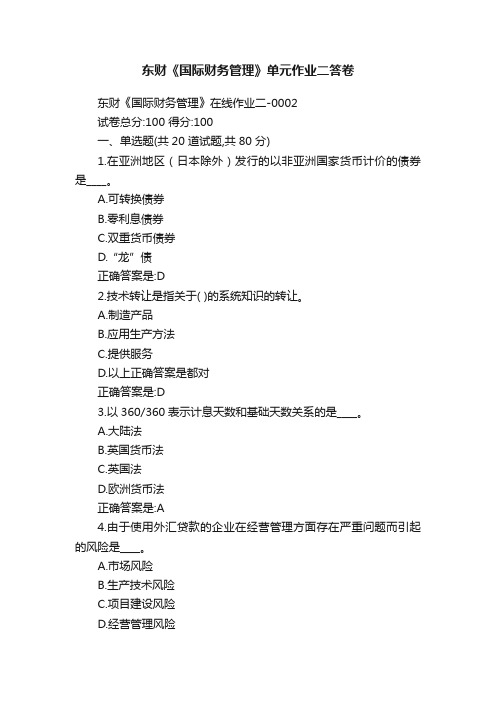
东财《国际财务管理》单元作业二答卷
东财《国际财务管理》在线作业二-0002
试卷总分:100 得分:100
一、单选题(共20 道试题,共80 分)
1.在亚洲地区(日本除外)发行的以非亚洲国家货币计价的债券是____。
A.可转换债券
B.零利息债券
C.双重货币债券
D.“龙”债
正确答案是:D
2.技术转让是指关于( )的系统知识的转让。
A.制造产品
B.应用生产方法
C.提供服务
D.以上正确答案是都对
正确答案是:D
3.以360/360表示计息天数和基础天数关系的是____。
A.大陆法
B.英国货币法
C.英国法
D.欧洲货币法
正确答案是:A
4.由于使用外汇贷款的企业在经营管理方面存在严重问题而引起的风险是____。
A.市场风险
B.生产技术风险
C.项目建设风险
D.经营管理风险
正确答案是:D
5.转移价格的制定权通常在____。
A.母公司
B.子公司
C.二者都可以
D.市场
正确答案是:A
6.购买力波动风险又可以称为____。
A.市场风险
B.利率风险
C.汇率风险
D.通货膨胀风险
正确答案是:D。
《国际财务管理》在线作业1-3作业参考答案及复习题与参考答案
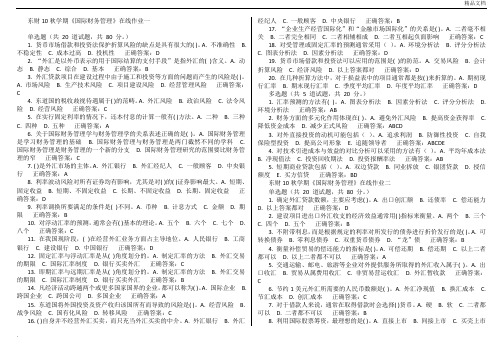
精品文档东财10秋学期《国际财务管理》在线作业一单选题(共20 道试题,共80 分。
)1. 货币市场借款和投资法保护折算风险的缺点是具有很大的( )。
A. 不准确性 B. 不稳定性 C. 成本过高 D. 投机性正确答案:D2. “外汇是以外币表示的用于国际结算的支付手段”是指外汇的( )含义。
A. 动态 B. 静态 C. 综合 D. 基本正确答案:B3. 外汇贷款项目在建设过程中由于施工和投资等方面的问题而产生的风险是( )。
A. 市场风险B. 生产技术风险C. 项目建设风险D. 经营管理风险正确答案:C4. 东道国的税收歧视待遇属于( )的范畴。
A. 外汇风险 B. 政治风险 C. 法令风险 D. 经营风险正确答案:C5. 在实行固定利率的情况下,还本付息的计算一般有( )方法。
A. 二种 B. 三种C. 四种D. 五种正确答案:A6. 关于国际财务管理学与财务管理学的关系表述正确的是( )。
A. 国际财务管理是学习财务管理的基础 B. 国际财务管理与财务管理是两门截然不同的学科 C. 国际财务管理是财务管理的一个新的分支 D. 国际财务管理研究的范围要比财务管理的窄正确答案:C7. ( )是外汇市场的主体。
A. 外汇银行 B. 外汇经纪人 C. 一般顾客 D. 中央银行正确答案:A8. 利率波动风险对所有证券均有影响,尤其是对( )的( )证券影响最大。
A. 短期、固定收益 B. 短期、不固定收益 C. 长期、不固定收益 D. 长期、固定收益正确答案:D9. 利率调换所要满足的条件是( )不同。
A. 币种 B. 计息方式 C. 金额 D. 期限正确答案:B10. 对浮动汇率的预测,通常会有( )基本的理论。
A. 五个 B. 六个 C. 七个 D. 八个正确答案:C11. 在我国现阶段,( )在经营外汇业务方面占主导地位。
A. 人民银行 B. 工商银行 C. 建设银行 D. 中国银行正确答案:D12. 固定汇率与浮动汇率是从( )角度划分的。
东财《国际财务管理》在线作业一答卷
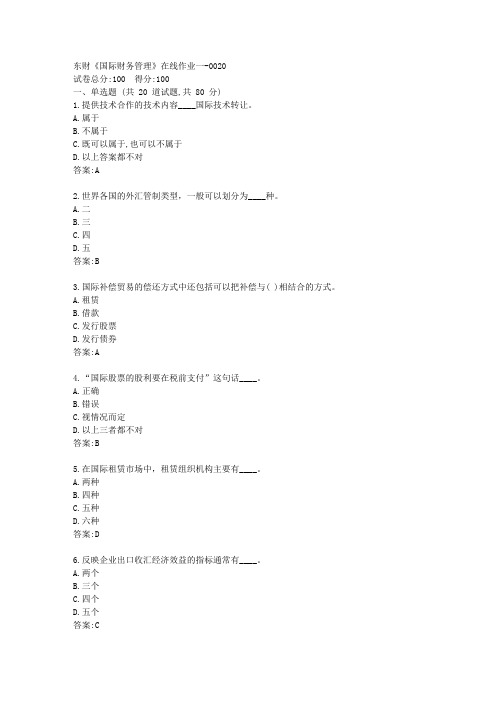
东财《国际财务管理》在线作业一-0020试卷总分:100 得分:100一、单选题 (共 20 道试题,共 80 分)1.提供技术合作的技术内容____国际技术转让。
A.属于B.不属于C.既可以属于,也可以不属于D.以上答案都不对答案:A2.世界各国的外汇管制类型,一般可以划分为____种。
A.二B.三C.四D.五答案:B3.国际补偿贸易的偿还方式中还包括可以把补偿与( )相结合的方式。
A.租赁B.借款C.发行股票D.发行债券答案:A4.“国际股票的股利要在税前支付”这句话____。
A.正确B.错误C.视情况而定D.以上三者都不对答案:B5.在国际租赁市场中,租赁组织机构主要有____。
A.两种B.四种C.五种D.六种答案:D6.反映企业出口收汇经济效益的指标通常有____。
A.两个B.三个C.四个D.五个答案:C7.在____下,外国货币数额固定不变,汇率涨跌都以相对的本国货币数额的变化来表示。
A.关键标价法B.套算标价法C.直接标价法D.间接标价法答案:C8.____又称为辛迪加贷款。
A.双边贷款B.同业拆放C.银团贷款D.授信额度答案:C9.通常情况下,国际股票的估价可以分为____情况。
A.两种B.三种C.四种D.五种答案:B10.即期汇率与远期汇率是从____角度划分的。
A.制定汇率的方法B.外汇交易的期限C.国际汇率制度D.银行买卖外汇答案:B11.在托收结算方式下,货款由____向银行办理托收。
A.进口国B.进口单位C.出口国D.出口单位答案:D12.通常情况下,国际债券的估价可以分为____情况。
A.两种B.三种C.四种D.五种答案:B13.“本金×复利现值系数”适用于____的估价。
A.每年支付一次利息,到期一次还本B.到期一次还本付息,不计复利C.贴现发行,不计利息D.以上答案都可以答案:C14.国际筹资的____阶段,企业以对外借款为主。
A.初始B.成长C.成熟D.衰退答案:A15.融资租赁通常是以____为目的的。
《国际财务管理》章后练习题及参考答案
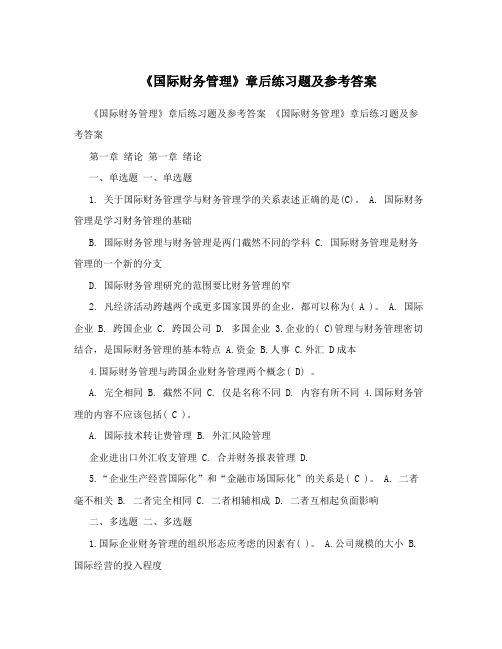
《国际财务管理》章后练习题及参考答案《国际财务管理》章后练习题及参考答案《国际财务管理》章后练习题及参考答案第一章绪论第一章绪论一、单选题一、单选题1. 关于国际财务管理学与财务管理学的关系表述正确的是(C)。
A. 国际财务管理是学习财务管理的基础B. 国际财务管理与财务管理是两门截然不同的学科C. 国际财务管理是财务管理的一个新的分支D. 国际财务管理研究的范围要比财务管理的窄2. 凡经济活动跨越两个或更多国家国界的企业,都可以称为( A )。
A. 国际企业 B. 跨国企业 C. 跨国公司 D. 多国企业3.企业的( C)管理与财务管理密切结合,是国际财务管理的基本特点 A.资金 B.人事 C.外汇 D成本4.国际财务管理与跨国企业财务管理两个概念( D) 。
A. 完全相同B. 截然不同C. 仅是名称不同D. 内容有所不同 4.国际财务管理的内容不应该包括( C )。
A. 国际技术转让费管理B. 外汇风险管理企业进出口外汇收支管理 C. 合并财务报表管理 D.5.“企业生产经营国际化”和“金融市场国际化”的关系是( C )。
A. 二者毫不相关 B. 二者完全相同 C. 二者相辅相成 D. 二者互相起负面影响二、多选题二、多选题1.国际企业财务管理的组织形态应考虑的因素有( )。
A.公司规模的大小 B.国际经营的投入程度C.管理经验的多少D.整个国际经营所采取的组织形式 2.国际财务管理体系的内容包括( )A.外汇风险的管理B.国际税收管理C.国际投筹资管理D.国际营运资金管 3.国际财务管理目标的特点( )。
A.稳定性B.多元性C.层次性D.复杂性4.广义的国际财务管理观包括( )。
A.世界统一财务管理观B.比较财务管理观C.跨国公司财务管理观D.国际企业财务管理观5. 我国企业的国际财务活动日益频繁,具体表现在( )。
A. 企业从内向型向外向型转化 B. 外贸专业公司有了新的发展 C. 在国内开办三资企业 D. 向国外投资办企业 E. 通过各种形式从国外筹集资金三、判断题三、判断题1.国际财务管理是对企业跨国的财务活动进行的管理。
东北财经大学网络-《国际财务管理》随堂练习
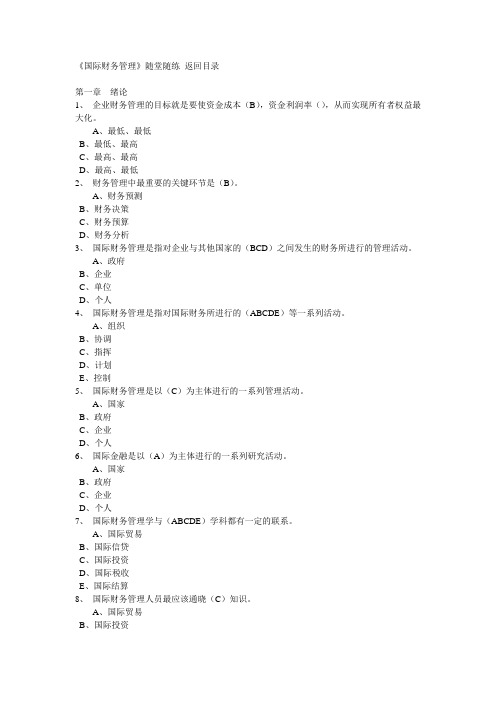
《国际财务管理》随堂随练返回目录第一章绪论1、企业财务管理的目标就是要使资金成本(B),资金利润率(),从而实现所有者权益最大化。
A、最低、最低B、最低、最高C、最高、最高D、最高、最低2、财务管理中最重要的关键环节是(B)。
A、财务预测B、财务决策C、财务预算D、财务分析3、国际财务管理是指对企业与其他国家的(BCD)之间发生的财务所进行的管理活动。
A、政府B、企业C、单位D、个人4、国际财务管理是指对国际财务所进行的(ABCDE)等一系列活动。
A、组织B、协调C、指挥D、计划E、控制5、国际财务管理是以(C)为主体进行的一系列管理活动。
A、国家B、政府C、企业D、个人6、国际金融是以(A)为主体进行的一系列研究活动。
A、国家B、政府C、企业D、个人7、国际财务管理学与(ABCDE)学科都有一定的联系。
A、国际贸易B、国际信贷C、国际投资D、国际税收E、国际结算8、国际财务管理人员最应该通晓(C)知识。
A、国际贸易B、国际投资C、国际金融D、国际税收9、在实际应用时,国际财务与国际金融在(A)方面是没有区别的。
A、英文名称B、角度C、范围D、内容10、关于国际财务管理学与财务管理学的关系表述正确的是(C)。
A、国际财务管理是学习财务管理的基础B、国际财务管理与财务管理是两门截然不同的学科C、国际财务管理是财务管理的一个新的分支D、国际财务管理研究的范围要比财务管理的窄11、西方财务管理是按照(B)进行分类得出的结论。
A、社会性质B、地理位置C、财务活动是否跨越本国国界D、政治制度12、国际财务管理与跨国企业财务管理两个概念(D)。
A、完全相同B、截然不同C、仅是名称不同D、内容有所不同13、国际财务管理与国际企业财务管理(D)。
A、完全相同B、截然不同C、仅是名称不同D、对象不同14、站在一个跨国公司的角度来考虑,国际财务管理与跨国公司财务管理的范围(C)。
A、前者大于后者B、前者等于后者C、前者小于后者D、二者没有任何关系15、国际财务管理与世界财务管理的关系是(B)。
东北财经大学智慧树知到“财务管理”《国际财务管理》网课测试题答案1

东北财经大学智慧树知到“财务管理”《国际财务管理》网课测试题答案(图片大小可自由调整)第1卷一.综合考核(共15题)1.长期外汇借款的成本率就是将各年支出的现值之和,与借款时的所得数额相比较,计算出来的____等于零时的折现率。
A.投资回收期B.净现值C.现值指数D.内部收益率2.技术引进方应选择付费____的那种方式。
A.最多B.最少C.等于零D.等于无穷大3.“国际补偿贸易中,国内企业不能以该项目的产品予以补偿”这句话____。
A、正确B、错误C、都可以D、其他4.以下不是冷热分析法中包括的影响因素的是____。
A.经济发展和成就B.市场机会C.外商股权D.文化一元化5.在补偿贸易时,对进口商品的选择通常应考虑()。
A.设备必须是我国急需的B.技术上要能够控制污染C.设备服务期要足够长D.设备的发展必须有好的前景6.影响利率变化的因素有()。
A.通货膨胀的高低B.国际收支状况C.汇率的变化D.货币政策的重大变化7.下列方法中计算最简单的是()。
A.区分流动与非流动法B.区分货币与非货币法C.时态法D.现行汇率法8.反映企业进口用汇经济效益的指标通常有()。
A、两个B、三个C、四个D、五个9.国际信贷的贷款利息决定于____因素。
A.本金B.利率C.汇率D.时间10.买入汇率(又称外汇买入价),是指()买入外汇时所使用的汇率。
A.国家B.企业C.银行D.个人11.境外子公司的不可控因素应该包括()。
A、外汇管制B、东道国经济发达水平C、管理水平D、收益分配12.国际筹资的()阶段,企业以对外借款为主。
A.初始B.成长C.成熟D.衰退13.可能会引起交易风险的交易过程包括()。
A.商品或劳务交易B.外汇借贷交易C.远期外汇交易D.以外汇进行投资14.对于股票持有者来说,并不是现实的收益,而只是一种无形收益的是____。
A、持有期间收益率B、本期股利收益率C、资产增值收益率D、以上答案都可以15.因国际间利率差别而引起的国际证券投资,往往是自发地从____利率国家向____利率国家流动。
东财《国际财务管理》在线作业一满分答案
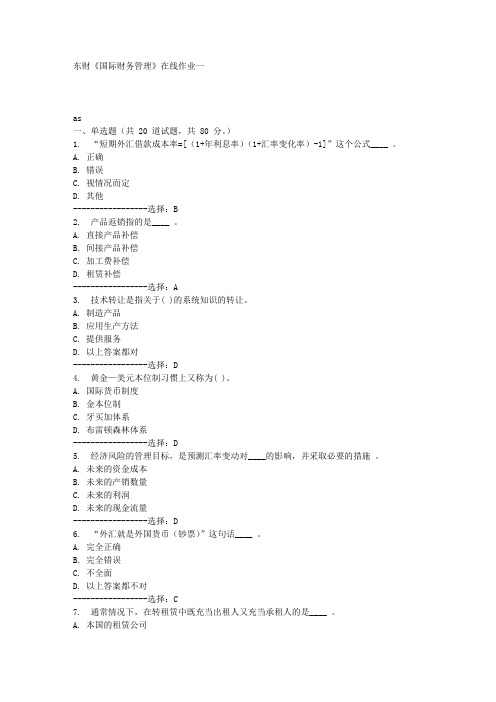
东财《国际财务管理》在线作业一
as
一、单选题(共 20 道试题,共 80 分。
)
1. “短期外汇借款成本率=[(1+年利息率)(1+汇率变化率)-1]”这个公式____ 。
A. 正确
B. 错误
C. 视情况而定
D. 其他
-----------------选择:B
2. 产品返销指的是____ 。
A. 直接产品补偿
B. 间接产品补偿
C. 加工费补偿
D. 租赁补偿
-----------------选择:A
3. 技术转让是指关于( )的系统知识的转让。
A. 制造产品
B. 应用生产方法
C. 提供服务
D. 以上答案都对
-----------------选择:D
4. 黄金—美元本位制习惯上又称为( )。
A. 国际货币制度
B. 金本位制
C. 牙买加体系
D. 布雷顿森林体系
-----------------选择:D
5. 经济风险的管理目标,是预测汇率变动对____的影响,并采取必要的措施。
A. 未来的资金成本
B. 未来的产销数量
C. 未来的利润
D. 未来的现金流量
-----------------选择:D
6. “外汇就是外国货币(钞票)”这句话____ 。
A. 完全正确
B. 完全错误
C. 不全面
D. 以上答案都不对
-----------------选择:C
7. 通常情况下,在转租赁中既充当出租人又充当承租人的是____ 。
A. 本国的租赁公司。
国际财务管理课后习题答案

国际财务管理
第四章 外汇汇率预测
• 1、
St 5
1 8%
1 5% • 2、 iA =(1+6%)×(1+5%)-1≈11.3% iB =(1+6%)×(1+8%)-1≈14.48%
SF 5 1 14 . 48 % 1 11 . 3 % 5 . 1429
108
1
110
1
9月1日,98 100 0 . 010204 0 . 01 0 . 000204 由此造成收益为:6250×(0.000204-0.0001683)≈0.23万美元
5、
卖出应收款100万英镑应收美元数
执行汇率 应收款到期日的 期权协 即期汇率 定价格 (汇率) 1英镑=1.58美元 1英镑=1.60美元 1英镑=1.63美元 1英镑=1.65美元 1英镑=1.67美元 1.63美元 1.63美元 1.63美元 1.63美元 1.63美元 1.63美元 1.63美元 1.63美元 1.65美元 1.67美元
第六章 外汇风险管理的策略 与方法
外汇现货市场
外汇期货市场
3月1日,
6250 110 56 . 82 万美元 62 . 5 万美元
3月1日,
9月1日,
6250 108
57 . 87 万美元
9月1日,
6250 100
6250 98
63 . 78 万美元
损失:62.5-56.82=5.68万美 收益:63.78- 57.87-0.5 元 =5.41万美元 • 现货市场的损失没有全部被期货市场的收益所抵补,相差 0.27万美元,其原因是: (1)支付外汇期货交易佣金0.5万美元 (2)期汇市场与现汇市场的汇率变动幅度不一致 3月1日,1 1 0 . 0092592 0 . 0090099 0 . 0001683
东北财经大学智慧树知到“财务管理”《国际财务管理》网课测试题答案2

东北财经大学智慧树知到“财务管理”《国际财务管理》网课测试题答案(图片大小可自由调整)第1卷一.综合考核(共15题)1.国际财务管理是以____为主体进行的一系列管理活动。
A.国家B.政府C.企业D.个人2.在对外谈判前应调查和分析的因素有____。
A.国内的资源情况B.国内的生产条件C.国际市场现状D.产品的销路E.产品的价格3.国际性外汇市场是指基本上不受政府外汇管制的自由外汇市场,比如()等都是国际性外汇市场。
A、伦敦B、纽约C、东京D、巴黎E、香港4.第一年股利除以(设定折先率-股利增长率)适用于____的估价。
A.长期投资,股利不断变化的股票B.长期投资,股利每年相等的股票短期投资C.股利每年以固定比率增长D.以上答案都可以5.在每次本息等额偿还这种计息方法中,还本付息定额的计算公式是()。
A.借款额×(F/P,i,n)B.借款额×(P/F,i,n)C.借款额×(P/F,i,n)÷(F/A,i,n)D.借款额×(F/P,i,n)÷(F/A,i,n)6.在两种方式选择的决策中,应该选用现金流出量____的方案。
A.最大B.最小C.等于零D.等于无穷大7.图表分析法中最基本的图是()。
A、条形图B、移动平均图C、线形图D、柱形图8.对项目做技术、经济和财务上的可行性研究是在____。
A.补偿阶段B.计划阶段C.对外谈判阶段D.选择贸易对象阶段9.债券发行者在国外金融市场发行的以外国货币为面值的债券是()。
A、外国债券B、欧洲债券C、国际债券D、国内债券10.套汇交易包括()。
A、时间套汇B、地点套汇C、利息套汇D、环境套汇E、人物套汇11.“到期的本利和复利现值系数”适用于____的估价。
A.每年支付一次利息,到期一次还本B.到期一次还本付息,不计复利C.贴现发行,不计利息D.以上答案都可以12.税收因素分析主要包括____。
A、税收优惠措施B、税务上对折旧问题的有关规定C、税收种类及税率高低D、东道国与母国的双边税务协定13.利率波动风险对所有证券均有影响,尤其是对()的()证券影响最大。
- 1、下载文档前请自行甄别文档内容的完整性,平台不提供额外的编辑、内容补充、找答案等附加服务。
- 2、"仅部分预览"的文档,不可在线预览部分如存在完整性等问题,可反馈申请退款(可完整预览的文档不适用该条件!)。
- 3、如文档侵犯您的权益,请联系客服反馈,我们会尽快为您处理(人工客服工作时间:9:00-18:30)。
一、单选题(共20 道试题,共80 分。
)1. 按出售资本项目所得收益所征收的税款是( B)。
A. 公司所得税B. 资本利得税C. 预扣税D. 个人所得税2.国际补偿贸易的偿还方式中还包括可以把补偿与(A )相结合的方式。
A. 租赁B. 借款C. 发行股票D. 发行债券3.证券投资组合中可以分散掉的风险只能是(B )。
A. 系统风险B. 非系统风险C. 市场风险D. 不可分散风险4.短期投资与长期投资是按证券投资的(D )而分类的。
A. 对象不同B. 收益是否固定C. 时期不同D. 目的不同5.国际财务管理与跨国企业财务管理两个概念_D___ 。
A. 完全相同B. 截然不同C. 仅是名称不同D. 内容有所不同6.货币市场借款和投资法保护折算风险的缺点是具有很大的( D)。
A. 不准确性B. 不稳定性C. 成本过高D. 投机性7.确定外汇贷款数额,主要应考虑(D )。
A. 出口创汇额B. 还债率C. 偿还能力D. 以上答案都对8.“短期外汇借款成本率=[年利息率(1+汇率变化率)+汇率变化率]×(1-所得税税率)”这个公式__A__ 。
A. 正确B. 错误C. 视情况而定D. 其他9.产品回购指的是_B___ 。
A. 直接产品补偿B. 间接产品补偿C. 加工费补偿D. 租赁补偿10.国际财务管理的特点不包括_D___ 。
A. 新的环境因素B. 新的风险来源C. 新的经济机会D. 新的管理方法11.一国国际收支顺差,则该国货币汇率就会_A___ 。
A. 上升B. 下降C. 不变D. 以上都有可能12.ADR是由(B )签发的。
A. 美国的企业B. 美国的银行C. 中国的企业D. 中国的银行13.B种股票是以(D )标明票面值的。
A. 美元B. 日元C. 德国马克D. 人民币14.财务代理人履行合同进行帐簿管理等服务所收取的费用是(B )。
A. 最初费用B. 债券管理费C. 还本手续费D. 付息手续费15.换取1美元外汇所需要的人民币数额是(B )。
A. 外汇净现值B. 换汇成本C. 节汇成本D. 创汇成本16.企业的外汇风险归根结底是由_B___引起的。
A. 外币计价B. 汇率变动C. 时间过长D. 本币计价17.国际菲莎效果(又译作国际费雪效应)建立了汇率和_B___之间的关系。
A. 通货膨胀率B. 名义利率C. 实际利率D. 远期汇率18.外汇交易的双方按照协定的汇率,就将来是否购买某种货币,或是否出售某种货币的选择权预先签订的一种合约是_C___ 。
A. 外汇择期B. 外汇调期C. 外汇期权D. 外汇期货19.国外投资是一种复杂的生产经营活动,尤其是( A)。
A. 国际直接投资B. 国际间接投资C. 国际债券投资D. 国际股票投资20.国际财务管理与国际企业财务管理_D___ 。
A. 完全相同B. 截然不同C. 仅是名称不同D. 对象不同二、多选题(共5 道试题,共20 分。
)1. 外汇借款的风险可能包括__ABCDE__ 。
A. 市场风险B. 生产技术风险C. 经营管理风险D. 利率风险E. 汇率风险2.短期外汇借款的成本包括()。
A. 本金B. 利息C. 筹资费用D. 外币折合差额3.国外投资与国内投资相比的特点是( ABD)。
A. 环境复杂B. 币种多C. 风险小D. 评估难度大4.财务方面的多元化作用体现在(ABCD )。
A. 避免外汇风险B. 提高资金获得率C. 降低资金成本D. 减少正式风险5.净收益这个指标的不足之处是(AC )。
A. 它是一个绝对数,不能反映经营效率B. 它是一个相对数,不能反映经营效率C. 采用这个指标容易使企业产生短期行为D. 采用这个指标容易使企业产生长期行为一、单选题(共20 道试题,共80 分。
)1. 股票收益一般包括(B )方面。
A. 两个B. 三个C. 四个D. 五个2.国际财务管理与国际企业财务管理_D___ 。
A. 完全相同B. 截然不同C. 仅是名称不同D. 对象不同3.国际财务管理的特点不包括_D___ 。
A. 新的环境因素B. 新的风险来源C. 新的经济机会D. 新的管理方法4.利率调换所要满足的条件是(B )不同。
A. 币种B. 计息方式C. 金额D. 期限5.建设项目进出口外汇收支的经济效益通常用( B)指标来衡量。
A. 两个B. 三个C. 四个D. 五个6.以下不是外汇收支结算中使用的主要票据的是__D__ 。
A. 汇票B. 本票C. 支票D. 发票7.长期外汇借款的成本应该按照_B___来计算。
A. 投资的风险价值原理B. 资金的时间价值原理C. 分配的利益均衡原理D. 筹资的效用最大原理8.利率波动风险对所有证券均有影响,尤其是对(D )的证券影响最大。
A. 短期、固定收益B. 短期、不固定收益C. 长期、不固定收益D. 长期、固定收益9.自营性租赁的最初一个阶段是_D___ 。
A. 签订合同阶段B. 支付租金阶段C. 对外谈判阶段D. 计划阶段10.通常情况下,在转租赁中既充当出租人又充当承租人的是_A___ 。
A. 本国的租赁公司B. 外国的租赁公司C. 承租人D. 以上三者都有可能11.对受管理或固定汇率的预测通常采用(D )。
A. 环境分析法B. 评分分析法C. 图表分析法D. 因素分析法12.补偿贸易中,设备进口方的待补偿金额是( B)。
A. 可偿还期B. 外资总成本C. 年外汇收入D. 年成本费用13.国际投资环境分析中的评分分析法共包括_D___因素。
A. 五个B. 六个C. 七个D. 八个14.国际财务管理的内容不应该包括_C___ 。
A. 国际技术转让费管理B. 外汇风险管理C. 合并财务报表管理D. 企业进出口外汇收支管理15. 无偏差理论说明,在没有干扰的情况下,当前的远期汇率应等于_C___的即期汇率。
A. 过去B. 现在C. 将来D. 以上答案都可以16.企业的外汇风险归根结底是由_B___引起的。
A. 外币计价B. 汇率变动C. 时间过长D. 本币计价17.直接标价与间接标价是_D___关系。
A. 没有B. 乘积C. 平方D. 倒数18.债券发行者在外国债券市场上发行,不是以该外国货币为面值的债券是_B___ 。
A. 外国债券B. 欧洲债券C. 国际债券D. 国内债券19.对受管理或固定汇率的预测最主要的就是预测贬值的(D )和幅度。
A. 范围B. 币种C. 原因D. 时间20.承租人租入设备后占用出租方的资金,由于分期支付租金而应支付给出租方的利息是_D___ 。
A. 租赁设备的价款B. 租赁业务的海运费、保险费C. 租赁手续费D. 融资利息二、多选题(共5 道试题,共20 分。
)1. 补偿贸易对于技术出口方的好处是(ABCD )。
A. 可以扩大商品出口B. 可以减少信贷风险C. 可以得到比较稳定的原料来源D. 可以获得一定的商业利润2.财务可行性分析一般包括(ABD )。
A. 预期利润分析B. 资金分析C. 现金流量分析D. 税收因素分析3.加强外汇收支管理可以采用的措施有(ABCDE )。
A. 事先认真做好可行性研究B. 加速原材料国产化C. 建立健全外汇收支管理制度D. 不断改进生产技术,提高出口产品竞争能力E. 努力开发新产品4.对承租人来说,国际租赁的缺点是(BD )。
A. 国际租赁实质上等于筹措一笔相当于设备价款的外资B. 租赁费较高C. 承租人对租赁物只有所有权D. 承租人对租赁物只有使用权5.在使用提成付费的方式下,合同中通常包括的内容有(ABCD )。
A. 提成年限B. 提成基数C. 提成比例D. 提成方式E. 提成的具体数额一、单选题(共20 道试题,共80 分。
)1.转移价格的制定权通常在_A___ 。
A. 母公司B. 子公司C. 二者都可以D. 市场2.在融资租赁方式下,租金中包含的融资利息通常是_A___的。
A. 递减B. 递增C. 不变D. 以上三者都有可能3.承租人租入设备后占用出租方的资金,由于分期支付租金而应支付给出租方的利息是__D__ 。
A. 租赁设备的价款B. 租赁业务的海运费、保险费C. 租赁手续费D. 融资利息4.自营性租赁程序中也可以叫做租赁阶段的是_B___A. 签订合同阶段B. 支付租金阶段C. 对外谈判阶段D. 计划阶段5.借款费用项目越多,费用率越高,则借款成本率(B )。
A. 不变B. 越高C. 越低D. 以上三者都有可能6.适用于跨国母公司和子公司之间纳税抵免的是_D___ 。
A. 免税B. 税收扣除C. 直接抵免D. 间接抵免7.国际菲莎效果(又译作国际费雪效应)建立了汇率和_B___之间的关系。
A. 通货膨胀率B. 名义利率C. 实际利率D. 远期汇率8.(B )自身并不经营外汇买卖,而只充当外汇买卖的中介。
A. 外汇银行B. 外汇经纪人C. 一般顾客D. 中央银行9.进口商所在国发生战争和内乱而使进口商无力付款是属于出口结算风险中的_A___ 。
A. 国家风险B. 商业风险C. 汇率风险D. 利率风险10.衡量国际股票与国际债券投资收益时都可以使用的指标是(A )。
A. 持有期间收益率B. 本期股利收益率C. 资产增值收益率D. 以上答案都可以11.证券投资风险可以分为(D )两种。
A. 系统风险与非系统风险B. 市场风险与公司个别风险C. 可分散风险与不可分散风险D. 以上答案都可以12.自营性租赁的程序大体上可以分为_D___阶段。
A. 三个B. 四个C. 五个D. 六个13.凡经济活动跨越两个或更多国家国界的企业,都可以称为(C )。
A. 国际企业B. 跨国企业C. 跨国公司D. 多国企业14.买入汇率(又称外汇买入价),是指_C___买入外汇时所使用的汇率。
A. 国家B. 企业C. 银行D. 个人15.“企业生产经营国际化”和“金融市场国际化”的关系是(C )。
A. 二者毫不相关B. 二者完全相同C. 二者相辅相成D. 二者互相起负面影响16.自营性租赁的最初一个阶段是_D___ 。
A. 签订合同阶段B. 支付租金阶段C. 对外谈判阶段D. 计划阶段17.“年现金股利除以股票的购入价格”衡量的是(B )。
A. 持有期间收益率B. 本期股利收益率C. 资产增值收益率D. 以上答案都可以18.消除通货膨胀影响的方法是_D___ 。
A. 重新设置帐册B. 重新记帐C. 重新编制新的报表D. 提供按物价指数调整的补充报表19.境外子公司的不可控因素不应该包括(D )。
A. 转移价格B. 通货膨胀C. 汇率波动D. 利率波动20.东道国的税收歧视待遇属于(C )的范畴。
A. 外汇风险B. 政治风险C. 法令风险D. 经营风险二、多选题(共5 道试题,共20 分。
)1. 在融资租赁方式下,租金的内容应包括_ABCD___ 。
